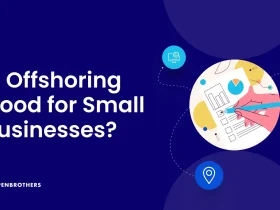Introduction: Why Does Purpose Matter for Your Business?
When you first started your business, you likely had a vision—a mission that felt genuine, something that drove you to wake up every day and give your best. But over time, things can get complicated. You’re faced with competition, ever-changing market trends, and countless distractions. It’s easy to feel like you’re just chasing sales instead of staying focused on the deeper reason your business exists.
But here’s the truth: defining and staying true to your business mission can actually be your greatest tool for success. The right mission isn’t just a catchy phrase or a line for your website—it can guide everything you do, from decision-making to connecting with your customers on a deeper level.
In this article, we’ll explore how aligning your business mission with your day-to-day operations can drive growth, foster brand loyalty, and set you apart from your competitors.
Why Is Having a Clear Business Mission Beneficial?
Having a clearly defined business purpose does more than just give you a sense of direction—it’s a powerful catalyst for growth. Here’s how:
- Attracting the Right Customers: People gravitate toward brands that share their values. When your mission is aligned with your target audience’s needs and desires, it helps you attract loyal customers who believe in your cause.
- Guiding Internal Culture: Employees are more motivated and aligned when they understand the mission. A well-defined purpose leads to higher engagement and better teamwork, translating into improved productivity.
- Better Decision-Making: With a mission at the heart of everything you do, decisions become easier. Whether it’s expanding your product line, choosing a marketing strategy, or hiring new talent, your mission acts as a reliable compass.
- Sustained Growth: Businesses with a strong purpose don’t just focus on short-term profits—they build long-lasting relationships with customers, which results in steady growth over time.
These benefits are real and measurable. But you may be wondering, how exactly do you define your business mission in a way that leads to growth?
Source: https://pedrovazpaulo.co/
What Does a “Business Mission” Really Mean?
Before diving into the ways a clear mission drives growth, let’s make sure we’re on the same page about what it actually means. A business mission is a statement that defines the core purpose of your company. It communicates why your business exists, what it seeks to achieve, and who it’s meant to serve.
Key Elements of a Strong Business Mission:
- Purpose: Why does your business exist?
- Vision: What are your long-term goals?
- Values: What principles guide your company?
- Customer Focus: Who are you serving, and what problems are you solving?
It’s the combination of these elements that gives your company direction and shapes its culture.
How Does Defining Your Mission Influence Business Growth?
Now that we know what a business mission is, let’s explore how it directly impacts your growth.
Strengthening Brand Identity
A clear mission helps your brand carve out a unique identity in a crowded market. It tells people exactly what you stand for and why they should care. Your brand values, communicated through your mission, will resonate with your target audience on a deeper emotional level, building trust and loyalty. This leads to higher customer retention and advocacy.
Improving Marketing and Messaging
With a defined mission, your messaging becomes more focused and effective. Whether it’s in your advertising, social media, or customer interactions, everything will align with your core message. When customers clearly understand your mission, they’ll be more likely to connect with your brand.
Example: Patagonia’s Mission in Action
Patagonia’s mission is a great example of how purpose can drive growth. They focus on environmental sustainability and corporate responsibility, which resonates with eco-conscious consumers. By aligning their business operations with this mission, they’ve fostered a loyal customer base that shares their values. This has contributed to their continued success in a highly competitive retail market.
Building Customer Loyalty
Customers today want more than just products—they want to buy into a cause. When they understand and believe in your business mission, they feel more connected to your brand. This emotional connection drives long-term loyalty, which is more valuable than a one-time purchase. Loyal customers will not only return but will also become brand advocates, spreading the word to others.
Enhancing Employee Engagement
Your employees are your company’s greatest asset. When your business mission is clear, employees understand the bigger picture and feel like they’re part of something meaningful. This leads to increased engagement, productivity, and lower turnover. A company with high employee satisfaction is more likely to see growth because of the positive work environment and the motivation that comes from being aligned with a shared purpose.
What Are the Steps to Defining a Strong Business Mission?
If you’re looking to define or refine your business mission, the following steps can guide you toward a meaningful and growth-driven statement.
1. Reflect on Your Purpose
Ask yourself: Why did you start this business? What problem are you solving, and for whom? Understanding the underlying purpose of your business is the foundation for creating a strong mission statement.
2. Involve Your Team
Your business mission isn’t just for the leadership team; it should reflect the values and ideas of everyone in your company. Gather input from your employees, and see what they believe the company stands for. This collaborative approach will ensure the mission resonates across all levels of the business.
3. Keep It Simple and Authentic
Your mission should be straightforward, memorable, and authentic. Avoid jargon or overly complicated language. Keep it simple and to the point, focusing on the key elements that drive your company’s existence.
4. Align Your Mission with Your Actions
A mission statement is meaningless if it’s not reflected in your actions. Everything from product development to customer service should align with your company’s purpose. This consistency builds credibility and trust among your audience.
Can a Business Mission Change Over Time?
Absolutely. As your business grows and evolves, your mission may also need to adapt. This doesn’t mean you should constantly change it to chase trends, but as your understanding of the market, your customers, and your core values deepen, a shift might be necessary. Always revisit your mission to ensure it’s still relevant and reflective of the path your business is taking.
Case Studies: Real-Life Examples of Purpose-Driven Growth
TOMS: A Mission with a Social Purpose
TOMS Shoes is a perfect example of a company where purpose drove growth. Their mission to donate a pair of shoes for every pair sold created a unique selling proposition. This mission wasn’t just a marketing tactic—it became the foundation of their brand and attracted a loyal customer base committed to making a positive impact.
Ben & Jerry’s: Purpose in Every Scoop
Ben & Jerry’s stands as another great example. The company’s mission of creating delicious ice cream while advocating for social justice issues has endeared them to a broad customer base. Their mission resonates deeply with people who care about both the environment and social equality, which has translated into consistent growth and brand loyalty.
How to Communicate Your Mission Effectively?
Once you’ve defined your business mission, the next step is ensuring it’s communicated effectively to your audience.
1. Integrate It into Your Branding
Your mission should be visible in every aspect of your branding. Whether it’s your website, social media, or packaging, make sure it’s clear to customers what your company stands for.
2. Show, Don’t Just Tell
Don’t just state your mission—live it. Demonstrate how your company’s actions align with its stated mission through your products, services, and corporate social responsibility efforts.
3. Engage Your Audience
Encourage customers and employees to participate in your mission. Create opportunities for them to get involved, whether it’s through social media campaigns, volunteering efforts, or customer feedback initiatives.
Conclusion: The Long-Term Benefits of a Clear Business Mission
Defining and sticking to a business mission isn’t just about having a catchy slogan—it’s about guiding your company through the complexities of growth, competition, and customer expectations.
The right mission can drive everything from brand loyalty to employee engagement, ultimately propelling your business toward long-term success. So, take the time to define your mission, align your actions with it, and watch as it leads you to sustained growth and greater impact.
Frequently Asked Questions
1. How Can a Small Business Define Its Mission Without Overcomplicating It?
Defining a business mission doesn’t have to be overwhelming, especially for small businesses. The key is to focus on what matters most: your core values and the problem you aim to solve for your customers. Start by asking yourself:
- Why did you start your business in the first place?
- What makes your product or service unique?
- How does your business make life better for your customers?
By keeping it simple and focusing on the heart of your business, you can craft a mission that resonates without getting bogged down in jargon.
For example, a local bakery may have a mission to “provide fresh, high-quality bread with ingredients sourced from local farms,” reflecting both the purpose and the unique selling point of their business. It’s about finding that genuine reason that connects you with your community.
2. What’s the Difference Between a Business Mission and a Vision Statement?
While both a mission statement and a vision statement are critical to business strategy, they serve different purposes.
- Business Mission: This focuses on the present—what your company does, how it operates, and who it serves. It’s action-oriented and should reflect your business’s purpose and core values.
- Vision Statement: This focuses on the future. It outlines where you want your business to go and what you hope to achieve long-term. It’s aspirational, often painting a picture of what success looks like.
For instance, Patagonia’s mission is to create environmentally responsible outdoor gear, while their vision is to “become the leading company in the business of sustainability.” Both work together to guide the company, but they have distinct roles in the business’s strategic direction.
3. Can a Business Mission Be Too Narrow or Too Broad?
Yes, a business mission can certainly be either too narrow or too broad, and finding the balance is key.
- Too Narrow: If your mission is overly specific, you may limit your business’s potential for growth. For example, a mission that says, “We make only eco-friendly shoes for people under 30,” could restrict your ability to expand into other demographics or product lines.
- Too Broad: On the other hand, a mission that’s too vague, like “We make high-quality products,” doesn’t communicate what your business stands for or who it serves. It lacks the clarity needed to connect with your target audience.
A good rule of thumb is to make sure your mission is specific enough to guide your actions but broad enough to allow for future growth. For instance, TOMS Shoes created a mission statement that’s simple but allows for flexibility: “Improving lives through business.”
4. How Do You Align Your Marketing Strategies with Your Business Mission?
Aligning your marketing strategies with your business mission is essential for consistent brand messaging and building trust with your audience. Here are some practical steps:
- Ensure Consistency: Every piece of marketing material, from your website to your social media campaigns, should reflect your mission. If your mission is about sustainability, for example, highlight your eco-friendly practices in your content and visuals.
- Engage Your Audience: Share stories or customer testimonials that demonstrate how your mission is making a difference. Content that highlights real-world impact can strengthen the emotional connection with your brand.
- Collaborate with Like-Minded Partners: Partnering with influencers or organizations that align with your mission can amplify your message. If your mission focuses on health and wellness, collaborating with wellness experts or nonprofits can increase credibility and visibility.
5. How Can You Measure the Impact of Your Business Mission on Growth?
Tracking the impact of your business mission on growth can be done through a combination of qualitative and quantitative measures.
- Customer Retention: If your mission resonates with your target audience, you should see higher customer retention rates. Loyal customers who connect with your purpose are more likely to return and even refer others.
- Employee Satisfaction and Engagement: A strong mission improves morale and productivity. Regular surveys or feedback loops can help measure whether employees feel aligned with the company’s mission.
- Brand Awareness: Over time, a mission-driven approach leads to greater recognition and a solid brand reputation. Tracking metrics like social media mentions, organic search traffic, and media coverage can help you measure the effectiveness of your mission in driving growth.
- Sales Growth: As customers align with your mission, your sales will reflect that connection. Tracking revenue growth and customer acquisition costs before and after emphasizing your mission will give you clear insights into its impact.







Leave a Reply